#Certified Professionals for Installation
Explore tagged Tumblr posts
Text
0 notes
Text
#24/7 electrician services#Certified Professional Residential Electrician Surrey#best local electrician near me#top-rated residential electrician services#residential electrician services#top-rated emergency electrician#affordable electrician langley#electrical standards ontario#electricians in langley bc#affordable electrician#24/7 Electrician Services Surrey#local electrician near me#electrical code ontario#looking for electrician near me#Licensed Residential Electrician Langley#electrician langley bc#Top-Rated Residential Electrician Services Langley#ev charger installation langley#langley electrician#cost to upgrade electrical panel#cost to update electrical panel#electrical fire how to put out#electrical code in ontario
0 notes
Text
Precision Heating Installation Built for Long-Term Comfort

When it comes to reliable indoor warmth, proper heating installation makes all the difference. At Global Green Solutions, we install high-efficiency furnaces, heat pumps, and complete HVAC systems with expert-level precision. From selecting the right-sized unit to optimizing ductwork and airflow, our team ensures your home stays warm, energy-efficient, and comfortable through every season. We don’t believe in one-size-fits-all—we assess your layout, insulation, and heating needs to design a custom solution that performs.
Don’t wait for the cold to creep in. Contact us now to schedule your heating installation and get the warmth you deserve.
For more information visit our website: Global Green Solutions 🌐 www.ggsar.com/ 📍 20746 Clarendon St, Woodland Hills, CA 91367 📞 Phone: (310) 269-0002 https://maps.app.goo.gl/E5KA6Eh9zbZfunGC6
#Heating Installation#Furnace Installation#HVAC Heating Services#Heat Pump Installation#Central Heating Installation#Residential Heating Installation#Commercial Heating Systems#Energy-Efficient Heating#Professional Heating Installers#Gas Furnace Installation#Electric Heater Installation#Whole Home Heating Solutions#Heating System Replacement#Certified HVAC Technicians#Home Heating Experts
1 note
·
View note
Text
Fast and Affordable Kitchen Installation in Coventry - All Kitchens Fitted
All Kitchens Fitted is a trusted provider of professional kitchen installation services in Coventry and the surrounding areas. As certified kitchen installers, we excel in delivering seamless kitchen installations that blend style, functionality, and craftsmanship.
Our experienced team offers a full range of services, including kitchen assembly services, new kitchen installation, and professional kitchen setup, ensuring every detail is meticulously managed. We also specialize in kitchen appliance fitting, guaranteeing that all units and fixtures are installed safely and precisely for lasting performance.
Recognized for our reliable kitchen installation services, we prioritize customer satisfaction through our commitment to quality, precision, and efficiency. Whether you're renovating or creating a new kitchen, All Kitchens Fitted is dedicated to transforming your space with expertise and care.

📍 Address: 60 Glenmore Dr, Longford, Coventry CV6 6LZ, United Kingdom
📞 Phone: 07774 646118
#Certified kitchen installers Coventry#Reliable kitchen installation services Coventry#Kitchen assembly Services in Coventry#Professional kitchen setup in Coventry
0 notes
Text
Looking for expert solar panel installation in Brisbane? 🌞 Quick Solar provides high-quality, efficient, and affordable solar solutions for residential and commercial properties. Our certified installers ensure seamless setup and long-term savings. Switch to solar today! ⚡🔋
#Solar Installers Brisbane#Professional Solar Installation#Solar Panel Installation Brisbane#Residential Solar Installation#Commercial Solar Installation#Best Solar Installers Brisbane#Solar Energy Solutions#Trusted Solar Company Brisbane#Affordable Solar Installation#Certified Solar Installers
0 notes
Text
The Best Flooring Options in Allambie Heights for Every Home
The Best Flooring Options in Allambie Heights for Every Home When it comes to transforming your home, few things have a greater impact than choosing the right flooring. From durability to aesthetics, your choice can set the tone for the entire space. If you’re in Allambie Heights and in need of flooring solutions, you’ve come to the right place. Whether you’re renovating an existing space or…
#--- The Best Flooring Options in Allambie Heights for Every Home --- When it comes to transforming your home#and bedrooms. If you prefer a sustainable#and easy to maintain#and long-lasting. Plus#and makes sure that your flooring lasts for years to come. Experienced professionals also have the right tools to achieve seamless finishes#and patterns available#and style. Soft textures help absorb sound and make a space feel cozy and inviting. With various fibers#as it is water-resistant#bathrooms#budget#but using gentle cleaners instead of harsh chemicals will keep them in top condition. Carpets should be vacuumed regularly to keep dust and#carpet#colors#easy to clean#eco-friendly option#ensuring your flooring is level#few things have a greater impact than choosing the right flooring. From durability to aesthetics#giving your home beauty without compromising on environmental impact. b) Vinyl Flooring For those seeking affordability and resilience#guaranteeing long-lasting beauty and durability for your space. Don&039;t settle for anything less than the best. If you&039;re ready to u#hallways#installation techniques#insulation#inviting atmosphere#making it a perfect choice for living rooms#many flooring services in Allambie Heights offer certified timber#modern look. Tiles are perfect for kitchens#one that can impact your daily life for many years. With a wide range of flooring options available#or eco-friendly#or tiles#or tiles. Allambie Heights Flooring experts recommend vinyl for high-traffic areas like kitchens and bathrooms
0 notes
Text
Empower Your Business with Private 5G and Professional Network Services
These settings, which most often are found in manufacturing facility, warehouse facilities, oil-and-gas venues, and colleges, are private 5G networks that lead to unprecedented wirelessly covered situations, reliability and security. What is required then is robust security and resilience which fulfills the given operational demands together with business interests. The need for the required infrastructure is what makes designing such an infrastructure be complex and may take time since it requires sufficient expertise.
At Highway 9 Networks, our specialty is professional network services tailored to support the full reality of private 5G technology in your organization. Our team of certified professionals in wireless designs and ensures smooth implementation, from RF planning and system integration to deployment and user training. Join with us today, and we help you avoid complexities in planning - create value for your business and accelerate time-to-service while optimizing operational efficiency.

Our expert services focus on building secure, adaptable mobile networks that empower mission-critical applications and enable groundbreaking digital transformation initiatives. Your private 5G deployment with Highway 9 Networks is not a technical upgrade; it's a strategic leap toward faster business outcomes and operational excellence.
Optimize your private 5G network by partnering with professionals who understand what you're trying to overcome: unique challenges from your environment. Let us design, deploy, and maximize your wireless future.
#professional network services#professional wireless network#professional network design#building a professional network#professional installation network#professional networking in the workplace#certified wireless design professional
0 notes
Text
Installation of Fire Alarm Systems

Installation of Fire Alarm Systems
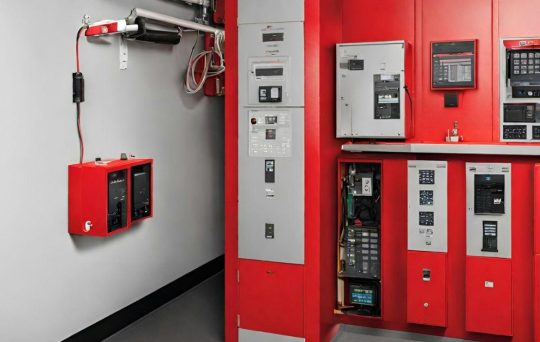
1. Importance of Fire Alarm Systems
The importance of fire alarm systems is evident in several aspects:
Protection from Hazards: They alert individuals in case of a fire, providing sufficient time to evacuate the building.
Reducing Financial Losses: Early detection of fire can minimize material damage and aid in preserving property.
Compliance with Legal Requirements: In many countries, installing fire alarm systems is mandatory in public and commercial buildings.
2. Types of Fire Alarm Systems
Fire alarm systems include several types, such as:
Manual Alarm Systems: Such as manual pull stations activated by individuals during an emergency.
Automatic Alarm Systems: These rely on sensors to detect smoke or heat and automatically issue alerts.
3. Steps for Installing Fire Alarm Systems
The steps for installing fire alarm systems can be summarized as follows:
Initial Assessment: Evaluate the building and identify the most vulnerable areas.
Choosing the Appropriate System: Select the suitable type of system based on the building’s needs.
Installation: Install sensors, alarms, and control panels professionally.
Testing and Confirmation: After installation, the system must be tested to ensure efficient operation.
4. Regular Maintenance
To ensure the continuous operation of the fire alarm system, regular maintenance is crucial. Maintenance includes:
Sensor Checks: Ensure their effectiveness and proper functioning.
Device Testing: Verify that all alarms operate correctly.
System Updates: Consider updating the system to keep pace with technological advancements.

5. Choosing a Professional Installation Company
It’s important to choose a reliable company for installing fire alarm systems. The company should have:
Experience: A long history in installing and maintaining alarm systems.
Licensing: Be licensed and certified by official authorities.
After-Sales Service: Provide support and maintenance services post-installation.
Installing fire alarm systems is a crucial step in protecting lives and property. The right system and professional installation ensure the system’s effectiveness. Don’t hesitate to contact Bidaya Company for a free consultation and reliable installation services.
Installation of Fire Alarm Systems
Fire alarm systems are among the most important safety elements in buildings, playing a vital role in protecting lives and property. Therefore, installing these systems is a complex process requiring expertise and technical knowledge. Here are additional details about installing fire alarm systems.
1. System Design
Before starting the installation process, the fire alarm system must be designed based on several factors, such as:
Building Size: Larger buildings require more complex systems that include multiple sensors and alarms.
Building Usage: The system design varies depending on the building’s purpose (residential, commercial, industrial).
Construction Materials: The materials used in the building affect how smoke and heat spread, impacting sensor installation locations.
2. Types of Sensors
Fire alarm sensors differ based on how they detect fire:
Smoke Sensors: Detect smoke particles in the air and vary between ionization and photoelectric smoke sensors.
Heat Sensors: Detect abnormal increases in temperature and include fixed and two-point sensors.
Flame Sensors: Detect flames using infrared or visible light and are effective in environments where high temperatures can cause false alarms.
3. Control Panels
Central control panels are essential components of the fire alarm system. They manage all sensors and alarms and include:
System Status Display: Shows the status of each sensor in the system, indicating whether it is in normal operation or detecting a fire.
Interaction Capabilities: Allow the user to interact with alerts and manually control the system.
Event Logging and Documentation: Some panels have event logging features, allowing for tracking and documenting any alerts that occur.
4. Safety Procedures During Installation
When installing a fire alarm system, it’s essential to adhere to several safety procedures to avoid any risks, including:
Power Shutdown: Ensure that all electrical systems are turned off during installation to avoid electrical shocks.
Using Appropriate Equipment: Utilize suitable installation tools and equipment to prevent damage to any components during installation.
Providing Adequate Ventilation: If using chemicals or adhesives, ensure proper ventilation to avoid inhaling harmful substances.

5. Training and Awareness
After installing the fire alarm system, training for workers or residents in the building on how to use the system is vital. Training includes:
Recognizing Fire Alarms: Clarifying how to recognize alarm signals and the importance of rapid response.
Evacuation Plans: Explaining the evacuation plan in case of fire, including safe routes and designated meeting areas.
6. Modern Technologies in Fire Alarm Systems
Modern technologies used in fire alarm systems include:
Integration with Other Security Systems: Such as surveillance and cameras, providing an additional level of security.
Alerts via Smartphones: Sending instant alerts to mobile devices in case of fire, allowing for quick action.
Artificial Intelligence Systems: Using AI to analyze data for detecting patterns and potential threats.
Installing fire alarm systems requires technical knowledge and high expertise to ensure their effective operation. It is essential to choose a reliable company like Bidaya Company to ensure the installation of a comprehensive system that complies with international safety standards and achieves maximum security.
Installation of Fire Alarm Systems
The installation of fire alarm systems is a vital step in enhancing safety within any building. These systems require careful planning and a deep understanding of the available technologies. In this context, we will delve into more details about installing fire alarm systems, along with keywords that enhance the article’s visibility in search engines.
1. Preliminary Planning for System Design
Before commencing the installation process, specialists should conduct a comprehensive site assessment. This includes:
Studying the Building Layout: Analyzing the layout to identify the most critical points for sensor installation, such as hallways, rooms, and enclosed spaces.
Identifying Hazard Sources: Pinpointing potential fire outbreak locations, such as kitchens and storage areas, to ensure nearby sensors are installed.

2. Modern Detection Technologies
Modern technologies used in fire alarm systems employ advanced methods to improve detection accuracy, including:
Advanced Sensors: Such as smart sensors capable of distinguishing between smoke from a fire and smoke from cooking.
Nano Technology: Utilizing it to develop lightweight and compact sensors that enhance system effectiveness.
3. Integration with Other Security Systems
Integrating fire alarm systems with other security systems in the facility provides an additional level of protection:
Automatic Fire Suppression Systems: Can work in tandem with alarms to extinguish fire in its early stages.
Audible Alarm Systems: Alert people inside the building to evacuate and can be connected to a public address system.
4. Installation Guidelines
When installing fire alarm systems, a set of guidelines must be followed to ensure efficient installation:
Avoid Interference: Sensors should be installed away from excessive heat sources, such as electric bulbs.
Consider Heights: Determine the appropriate height for sensor installation based on their type. For example, smoke sensors should be installed 30-60 cm from the ceiling.
Correct Orientation: Position sensors effectively toward areas where smoke accumulates.
5. Performance Testing
After installation, comprehensive performance tests should be conducted to verify the system’s effectiveness:
Simulation Tests: Simulate fire scenarios using artificial smoke to ensure the system responds appropriately.
Performance Evaluation: Measure the sensors’ response time and accuracy in detecting fire locations.
6. Periodic Maintenance Strategies
Fire alarm systems require regular maintenance to ensure ongoing efficiency:
Schedule Inspections: Develop a plan to inspect systems periodically, at least once every six months.
System Updates: Consider updating the system in line with the latest available technologies.
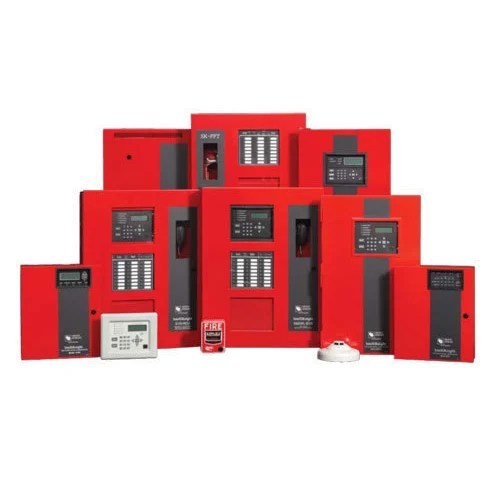
Keywords
Installation of fire alarm systems
Fire protection
Automatic alarm systems
Smoke sensors
Fire system maintenance
Fire detection technologies
Integrated security systems
Importance of alarm systems
Fire system performance testing
Design of fire alarm systems
The installation of fire alarm systems requires dedication and high technical knowledge. Ensure to choose a professional company like Bidaya Company to guarantee an effective system installation that achieves the highest safety standards. If you have any inquiries or need consultation, please do not hesitate to contact us!
#Top-rated fire safety services Dammam#Professional fire suppression system installation Jeddah#Fire safety audits and system installation Jubail#Fire fighting network installation company near me#Certified fire alarm system installers Riyadh#Affordable fire protection installation Medina
0 notes
Text
Installation of Fire Alarm Systems

Installation of Fire Alarm Systems
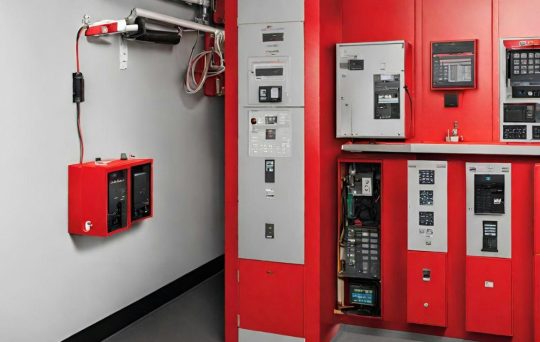
1. Importance of Fire Alarm Systems
The importance of fire alarm systems is evident in several aspects:
Protection from Hazards: They alert individuals in case of a fire, providing sufficient time to evacuate the building.
Reducing Financial Losses: Early detection of fire can minimize material damage and aid in preserving property.
Compliance with Legal Requirements: In many countries, installing fire alarm systems is mandatory in public and commercial buildings.
2. Types of Fire Alarm Systems
Fire alarm systems include several types, such as:
Manual Alarm Systems: Such as manual pull stations activated by individuals during an emergency.
Automatic Alarm Systems: These rely on sensors to detect smoke or heat and automatically issue alerts.
3. Steps for Installing Fire Alarm Systems
The steps for installing fire alarm systems can be summarized as follows:
Initial Assessment: Evaluate the building and identify the most vulnerable areas.
Choosing the Appropriate System: Select the suitable type of system based on the building’s needs.
Installation: Install sensors, alarms, and control panels professionally.
Testing and Confirmation: After installation, the system must be tested to ensure efficient operation.
4. Regular Maintenance
To ensure the continuous operation of the fire alarm system, regular maintenance is crucial. Maintenance includes:
Sensor Checks: Ensure their effectiveness and proper functioning.
Device Testing: Verify that all alarms operate correctly.
System Updates: Consider updating the system to keep pace with technological advancements.

5. Choosing a Professional Installation Company
It’s important to choose a reliable company for installing fire alarm systems. The company should have:
Experience: A long history in installing and maintaining alarm systems.
Licensing: Be licensed and certified by official authorities.
After-Sales Service: Provide support and maintenance services post-installation.
Installing fire alarm systems is a crucial step in protecting lives and property. The right system and professional installation ensure the system’s effectiveness. Don’t hesitate to contact Bidaya Company for a free consultation and reliable installation services.
Installation of Fire Alarm Systems
Fire alarm systems are among the most important safety elements in buildings, playing a vital role in protecting lives and property. Therefore, installing these systems is a complex process requiring expertise and technical knowledge. Here are additional details about installing fire alarm systems.
1. System Design
Before starting the installation process, the fire alarm system must be designed based on several factors, such as:
Building Size: Larger buildings require more complex systems that include multiple sensors and alarms.
Building Usage: The system design varies depending on the building’s purpose (residential, commercial, industrial).
Construction Materials: The materials used in the building affect how smoke and heat spread, impacting sensor installation locations.
2. Types of Sensors
Fire alarm sensors differ based on how they detect fire:
Smoke Sensors: Detect smoke particles in the air and vary between ionization and photoelectric smoke sensors.
Heat Sensors: Detect abnormal increases in temperature and include fixed and two-point sensors.
Flame Sensors: Detect flames using infrared or visible light and are effective in environments where high temperatures can cause false alarms.
3. Control Panels
Central control panels are essential components of the fire alarm system. They manage all sensors and alarms and include:
System Status Display: Shows the status of each sensor in the system, indicating whether it is in normal operation or detecting a fire.
Interaction Capabilities: Allow the user to interact with alerts and manually control the system.
Event Logging and Documentation: Some panels have event logging features, allowing for tracking and documenting any alerts that occur.
4. Safety Procedures During Installation
When installing a fire alarm system, it’s essential to adhere to several safety procedures to avoid any risks, including:
Power Shutdown: Ensure that all electrical systems are turned off during installation to avoid electrical shocks.
Using Appropriate Equipment: Utilize suitable installation tools and equipment to prevent damage to any components during installation.
Providing Adequate Ventilation: If using chemicals or adhesives, ensure proper ventilation to avoid inhaling harmful substances.

5. Training and Awareness
After installing the fire alarm system, training for workers or residents in the building on how to use the system is vital. Training includes:
Recognizing Fire Alarms: Clarifying how to recognize alarm signals and the importance of rapid response.
Evacuation Plans: Explaining the evacuation plan in case of fire, including safe routes and designated meeting areas.
6. Modern Technologies in Fire Alarm Systems
Modern technologies used in fire alarm systems include:
Integration with Other Security Systems: Such as surveillance and cameras, providing an additional level of security.
Alerts via Smartphones: Sending instant alerts to mobile devices in case of fire, allowing for quick action.
Artificial Intelligence Systems: Using AI to analyze data for detecting patterns and potential threats.
Installing fire alarm systems requires technical knowledge and high expertise to ensure their effective operation. It is essential to choose a reliable company like Bidaya Company to ensure the installation of a comprehensive system that complies with international safety standards and achieves maximum security.
Installation of Fire Alarm Systems
The installation of fire alarm systems is a vital step in enhancing safety within any building. These systems require careful planning and a deep understanding of the available technologies. In this context, we will delve into more details about installing fire alarm systems, along with keywords that enhance the article’s visibility in search engines.
1. Preliminary Planning for System Design
Before commencing the installation process, specialists should conduct a comprehensive site assessment. This includes:
Studying the Building Layout: Analyzing the layout to identify the most critical points for sensor installation, such as hallways, rooms, and enclosed spaces.
Identifying Hazard Sources: Pinpointing potential fire outbreak locations, such as kitchens and storage areas, to ensure nearby sensors are installed.
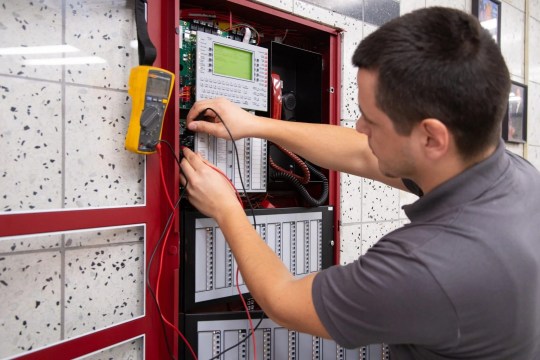
2. Modern Detection Technologies
Modern technologies used in fire alarm systems employ advanced methods to improve detection accuracy, including:
Advanced Sensors: Such as smart sensors capable of distinguishing between smoke from a fire and smoke from cooking.
Nano Technology: Utilizing it to develop lightweight and compact sensors that enhance system effectiveness.
3. Integration with Other Security Systems
Integrating fire alarm systems with other security systems in the facility provides an additional level of protection:
Automatic Fire Suppression Systems: Can work in tandem with alarms to extinguish fire in its early stages.
Audible Alarm Systems: Alert people inside the building to evacuate and can be connected to a public address system.
4. Installation Guidelines
When installing fire alarm systems, a set of guidelines must be followed to ensure efficient installation:
Avoid Interference: Sensors should be installed away from excessive heat sources, such as electric bulbs.
Consider Heights: Determine the appropriate height for sensor installation based on their type. For example, smoke sensors should be installed 30-60 cm from the ceiling.
Correct Orientation: Position sensors effectively toward areas where smoke accumulates.
5. Performance Testing
After installation, comprehensive performance tests should be conducted to verify the system’s effectiveness:
Simulation Tests: Simulate fire scenarios using artificial smoke to ensure the system responds appropriately.
Performance Evaluation: Measure the sensors’ response time and accuracy in detecting fire locations.
6. Periodic Maintenance Strategies
Fire alarm systems require regular maintenance to ensure ongoing efficiency:
Schedule Inspections: Develop a plan to inspect systems periodically, at least once every six months.
System Updates: Consider updating the system in line with the latest available technologies.

Keywords
Installation of fire alarm systems
Fire protection
Automatic alarm systems
Smoke sensors
Fire system maintenance
Fire detection technologies
Integrated security systems
Importance of alarm systems
Fire system performance testing
Design of fire alarm systems
The installation of fire alarm systems requires dedication and high technical knowledge. Ensure to choose a professional company like Bidaya Company to guarantee an effective system installation that achieves the highest safety standards. If you have any inquiries or need consultation, please do not hesitate to contact us!
#Top-rated fire safety services Dammam#Professional fire suppression system installation Jeddah#Fire safety audits and system installation Jubail#Fire fighting network installation company near me#Certified fire alarm system installers Riyadh#Affordable fire protection installation Medina
0 notes
Text
Installation of Fire Alarm Systems

Installation of Fire Alarm Systems
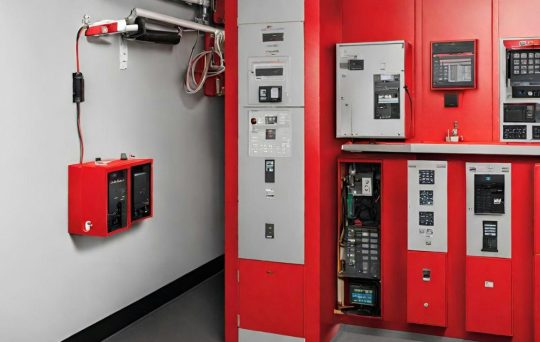
1. Importance of Fire Alarm Systems
The importance of fire alarm systems is evident in several aspects:
Protection from Hazards: They alert individuals in case of a fire, providing sufficient time to evacuate the building.
Reducing Financial Losses: Early detection of fire can minimize material damage and aid in preserving property.
Compliance with Legal Requirements: In many countries, installing fire alarm systems is mandatory in public and commercial buildings.
2. Types of Fire Alarm Systems
Fire alarm systems include several types, such as:
Manual Alarm Systems: Such as manual pull stations activated by individuals during an emergency.
Automatic Alarm Systems: These rely on sensors to detect smoke or heat and automatically issue alerts.
3. Steps for Installing Fire Alarm Systems
The steps for installing fire alarm systems can be summarized as follows:
Initial Assessment: Evaluate the building and identify the most vulnerable areas.
Choosing the Appropriate System: Select the suitable type of system based on the building’s needs.
Installation: Install sensors, alarms, and control panels professionally.
Testing and Confirmation: After installation, the system must be tested to ensure efficient operation.
4. Regular Maintenance
To ensure the continuous operation of the fire alarm system, regular maintenance is crucial. Maintenance includes:
Sensor Checks: Ensure their effectiveness and proper functioning.
Device Testing: Verify that all alarms operate correctly.
System Updates: Consider updating the system to keep pace with technological advancements.

5. Choosing a Professional Installation Company
It’s important to choose a reliable company for installing fire alarm systems. The company should have:
Experience: A long history in installing and maintaining alarm systems.
Licensing: Be licensed and certified by official authorities.
After-Sales Service: Provide support and maintenance services post-installation.
Installing fire alarm systems is a crucial step in protecting lives and property. The right system and professional installation ensure the system’s effectiveness. Don’t hesitate to contact Bidaya Company for a free consultation and reliable installation services.
Installation of Fire Alarm Systems
Fire alarm systems are among the most important safety elements in buildings, playing a vital role in protecting lives and property. Therefore, installing these systems is a complex process requiring expertise and technical knowledge. Here are additional details about installing fire alarm systems.
1. System Design
Before starting the installation process, the fire alarm system must be designed based on several factors, such as:
Building Size: Larger buildings require more complex systems that include multiple sensors and alarms.
Building Usage: The system design varies depending on the building’s purpose (residential, commercial, industrial).
Construction Materials: The materials used in the building affect how smoke and heat spread, impacting sensor installation locations.
2. Types of Sensors
Fire alarm sensors differ based on how they detect fire:
Smoke Sensors: Detect smoke particles in the air and vary between ionization and photoelectric smoke sensors.
Heat Sensors: Detect abnormal increases in temperature and include fixed and two-point sensors.
Flame Sensors: Detect flames using infrared or visible light and are effective in environments where high temperatures can cause false alarms.
3. Control Panels
Central control panels are essential components of the fire alarm system. They manage all sensors and alarms and include:
System Status Display: Shows the status of each sensor in the system, indicating whether it is in normal operation or detecting a fire.
Interaction Capabilities: Allow the user to interact with alerts and manually control the system.
Event Logging and Documentation: Some panels have event logging features, allowing for tracking and documenting any alerts that occur.
4. Safety Procedures During Installation
When installing a fire alarm system, it’s essential to adhere to several safety procedures to avoid any risks, including:
Power Shutdown: Ensure that all electrical systems are turned off during installation to avoid electrical shocks.
Using Appropriate Equipment: Utilize suitable installation tools and equipment to prevent damage to any components during installation.
Providing Adequate Ventilation: If using chemicals or adhesives, ensure proper ventilation to avoid inhaling harmful substances.

5. Training and Awareness
After installing the fire alarm system, training for workers or residents in the building on how to use the system is vital. Training includes:
Recognizing Fire Alarms: Clarifying how to recognize alarm signals and the importance of rapid response.
Evacuation Plans: Explaining the evacuation plan in case of fire, including safe routes and designated meeting areas.
6. Modern Technologies in Fire Alarm Systems
Modern technologies used in fire alarm systems include:
Integration with Other Security Systems: Such as surveillance and cameras, providing an additional level of security.
Alerts via Smartphones: Sending instant alerts to mobile devices in case of fire, allowing for quick action.
Artificial Intelligence Systems: Using AI to analyze data for detecting patterns and potential threats.
Installing fire alarm systems requires technical knowledge and high expertise to ensure their effective operation. It is essential to choose a reliable company like Bidaya Company to ensure the installation of a comprehensive system that complies with international safety standards and achieves maximum security.
Installation of Fire Alarm Systems
The installation of fire alarm systems is a vital step in enhancing safety within any building. These systems require careful planning and a deep understanding of the available technologies. In this context, we will delve into more details about installing fire alarm systems, along with keywords that enhance the article’s visibility in search engines.
1. Preliminary Planning for System Design
Before commencing the installation process, specialists should conduct a comprehensive site assessment. This includes:
Studying the Building Layout: Analyzing the layout to identify the most critical points for sensor installation, such as hallways, rooms, and enclosed spaces.
Identifying Hazard Sources: Pinpointing potential fire outbreak locations, such as kitchens and storage areas, to ensure nearby sensors are installed.
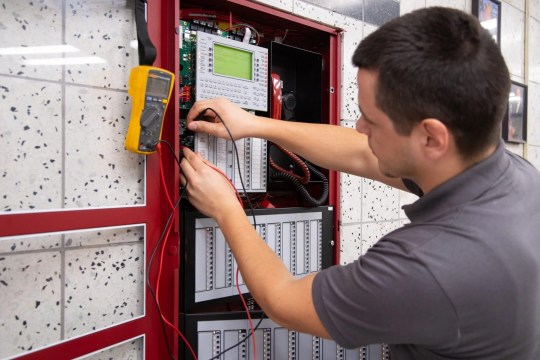
2. Modern Detection Technologies
Modern technologies used in fire alarm systems employ advanced methods to improve detection accuracy, including:
Advanced Sensors: Such as smart sensors capable of distinguishing between smoke from a fire and smoke from cooking.
Nano Technology: Utilizing it to develop lightweight and compact sensors that enhance system effectiveness.
3. Integration with Other Security Systems
Integrating fire alarm systems with other security systems in the facility provides an additional level of protection:
Automatic Fire Suppression Systems: Can work in tandem with alarms to extinguish fire in its early stages.
Audible Alarm Systems: Alert people inside the building to evacuate and can be connected to a public address system.
4. Installation Guidelines
When installing fire alarm systems, a set of guidelines must be followed to ensure efficient installation:
Avoid Interference: Sensors should be installed away from excessive heat sources, such as electric bulbs.
Consider Heights: Determine the appropriate height for sensor installation based on their type. For example, smoke sensors should be installed 30-60 cm from the ceiling.
Correct Orientation: Position sensors effectively toward areas where smoke accumulates.
5. Performance Testing
After installation, comprehensive performance tests should be conducted to verify the system’s effectiveness:
Simulation Tests: Simulate fire scenarios using artificial smoke to ensure the system responds appropriately.
Performance Evaluation: Measure the sensors’ response time and accuracy in detecting fire locations.
6. Periodic Maintenance Strategies
Fire alarm systems require regular maintenance to ensure ongoing efficiency:
Schedule Inspections: Develop a plan to inspect systems periodically, at least once every six months.
System Updates: Consider updating the system in line with the latest available technologies.
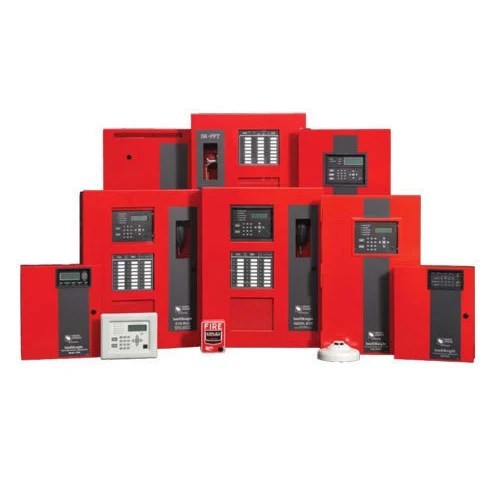
Keywords
Installation of fire alarm systems
Fire protection
Automatic alarm systems
Smoke sensors
Fire system maintenance
Fire detection technologies
Integrated security systems
Importance of alarm systems
Fire system performance testing
Design of fire alarm systems
The installation of fire alarm systems requires dedication and high technical knowledge. Ensure to choose a professional company like Bidaya Company to guarantee an effective system installation that achieves the highest safety standards. If you have any inquiries or need consultation, please do not hesitate to contact us!
#Top-rated fire safety services Dammam#Professional fire suppression system installation Jeddah#Fire safety audits and system installation Jubail#Fire fighting network installation company near me#Certified fire alarm system installers Riyadh#Affordable fire protection installation Medina
0 notes
Text
Installation of Fire Alarm Systems

Installation of Fire Alarm Systems
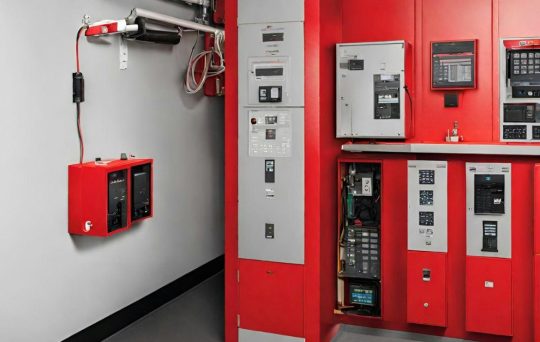
1. Importance of Fire Alarm Systems
The importance of fire alarm systems is evident in several aspects:
Protection from Hazards: They alert individuals in case of a fire, providing sufficient time to evacuate the building.
Reducing Financial Losses: Early detection of fire can minimize material damage and aid in preserving property.
Compliance with Legal Requirements: In many countries, installing fire alarm systems is mandatory in public and commercial buildings.
2. Types of Fire Alarm Systems
Fire alarm systems include several types, such as:
Manual Alarm Systems: Such as manual pull stations activated by individuals during an emergency.
Automatic Alarm Systems: These rely on sensors to detect smoke or heat and automatically issue alerts.
3. Steps for Installing Fire Alarm Systems
The steps for installing fire alarm systems can be summarized as follows:
Initial Assessment: Evaluate the building and identify the most vulnerable areas.
Choosing the Appropriate System: Select the suitable type of system based on the building’s needs.
Installation: Install sensors, alarms, and control panels professionally.
Testing and Confirmation: After installation, the system must be tested to ensure efficient operation.
4. Regular Maintenance
To ensure the continuous operation of the fire alarm system, regular maintenance is crucial. Maintenance includes:
Sensor Checks: Ensure their effectiveness and proper functioning.
Device Testing: Verify that all alarms operate correctly.
System Updates: Consider updating the system to keep pace with technological advancements.

5. Choosing a Professional Installation Company
It’s important to choose a reliable company for installing fire alarm systems. The company should have:
Experience: A long history in installing and maintaining alarm systems.
Licensing: Be licensed and certified by official authorities.
After-Sales Service: Provide support and maintenance services post-installation.
Installing fire alarm systems is a crucial step in protecting lives and property. The right system and professional installation ensure the system’s effectiveness. Don’t hesitate to contact Bidaya Company for a free consultation and reliable installation services.
Installation of Fire Alarm Systems
Fire alarm systems are among the most important safety elements in buildings, playing a vital role in protecting lives and property. Therefore, installing these systems is a complex process requiring expertise and technical knowledge. Here are additional details about installing fire alarm systems.
1. System Design
Before starting the installation process, the fire alarm system must be designed based on several factors, such as:
Building Size: Larger buildings require more complex systems that include multiple sensors and alarms.
Building Usage: The system design varies depending on the building’s purpose (residential, commercial, industrial).
Construction Materials: The materials used in the building affect how smoke and heat spread, impacting sensor installation locations.
2. Types of Sensors
Fire alarm sensors differ based on how they detect fire:
Smoke Sensors: Detect smoke particles in the air and vary between ionization and photoelectric smoke sensors.
Heat Sensors: Detect abnormal increases in temperature and include fixed and two-point sensors.
Flame Sensors: Detect flames using infrared or visible light and are effective in environments where high temperatures can cause false alarms.
3. Control Panels
Central control panels are essential components of the fire alarm system. They manage all sensors and alarms and include:
System Status Display: Shows the status of each sensor in the system, indicating whether it is in normal operation or detecting a fire.
Interaction Capabilities: Allow the user to interact with alerts and manually control the system.
Event Logging and Documentation: Some panels have event logging features, allowing for tracking and documenting any alerts that occur.
4. Safety Procedures During Installation
When installing a fire alarm system, it’s essential to adhere to several safety procedures to avoid any risks, including:
Power Shutdown: Ensure that all electrical systems are turned off during installation to avoid electrical shocks.
Using Appropriate Equipment: Utilize suitable installation tools and equipment to prevent damage to any components during installation.
Providing Adequate Ventilation: If using chemicals or adhesives, ensure proper ventilation to avoid inhaling harmful substances.

5. Training and Awareness
After installing the fire alarm system, training for workers or residents in the building on how to use the system is vital. Training includes:
Recognizing Fire Alarms: Clarifying how to recognize alarm signals and the importance of rapid response.
Evacuation Plans: Explaining the evacuation plan in case of fire, including safe routes and designated meeting areas.
6. Modern Technologies in Fire Alarm Systems
Modern technologies used in fire alarm systems include:
Integration with Other Security Systems: Such as surveillance and cameras, providing an additional level of security.
Alerts via Smartphones: Sending instant alerts to mobile devices in case of fire, allowing for quick action.
Artificial Intelligence Systems: Using AI to analyze data for detecting patterns and potential threats.
Installing fire alarm systems requires technical knowledge and high expertise to ensure their effective operation. It is essential to choose a reliable company like Bidaya Company to ensure the installation of a comprehensive system that complies with international safety standards and achieves maximum security.
Installation of Fire Alarm Systems
The installation of fire alarm systems is a vital step in enhancing safety within any building. These systems require careful planning and a deep understanding of the available technologies. In this context, we will delve into more details about installing fire alarm systems, along with keywords that enhance the article’s visibility in search engines.
1. Preliminary Planning for System Design
Before commencing the installation process, specialists should conduct a comprehensive site assessment. This includes:
Studying the Building Layout: Analyzing the layout to identify the most critical points for sensor installation, such as hallways, rooms, and enclosed spaces.
Identifying Hazard Sources: Pinpointing potential fire outbreak locations, such as kitchens and storage areas, to ensure nearby sensors are installed.

2. Modern Detection Technologies
Modern technologies used in fire alarm systems employ advanced methods to improve detection accuracy, including:
Advanced Sensors: Such as smart sensors capable of distinguishing between smoke from a fire and smoke from cooking.
Nano Technology: Utilizing it to develop lightweight and compact sensors that enhance system effectiveness.
3. Integration with Other Security Systems
Integrating fire alarm systems with other security systems in the facility provides an additional level of protection:
Automatic Fire Suppression Systems: Can work in tandem with alarms to extinguish fire in its early stages.
Audible Alarm Systems: Alert people inside the building to evacuate and can be connected to a public address system.
4. Installation Guidelines
When installing fire alarm systems, a set of guidelines must be followed to ensure efficient installation:
Avoid Interference: Sensors should be installed away from excessive heat sources, such as electric bulbs.
Consider Heights: Determine the appropriate height for sensor installation based on their type. For example, smoke sensors should be installed 30-60 cm from the ceiling.
Correct Orientation: Position sensors effectively toward areas where smoke accumulates.
5. Performance Testing
After installation, comprehensive performance tests should be conducted to verify the system’s effectiveness:
Simulation Tests: Simulate fire scenarios using artificial smoke to ensure the system responds appropriately.
Performance Evaluation: Measure the sensors’ response time and accuracy in detecting fire locations.
6. Periodic Maintenance Strategies
Fire alarm systems require regular maintenance to ensure ongoing efficiency:
Schedule Inspections: Develop a plan to inspect systems periodically, at least once every six months.
System Updates: Consider updating the system in line with the latest available technologies.
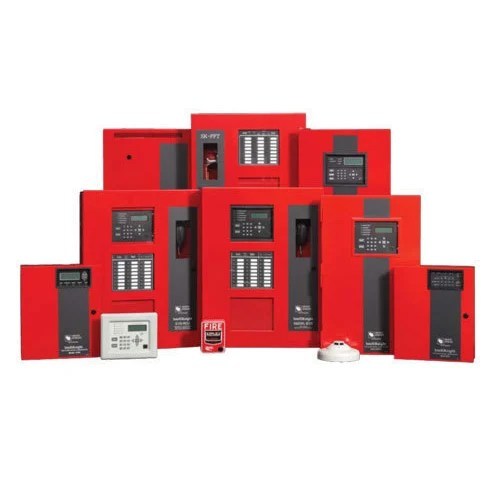
Keywords
Installation of fire alarm systems
Fire protection
Automatic alarm systems
Smoke sensors
Fire system maintenance
Fire detection technologies
Integrated security systems
Importance of alarm systems
Fire system performance testing
Design of fire alarm systems
The installation of fire alarm systems requires dedication and high technical knowledge. Ensure to choose a professional company like Bidaya Company to guarantee an effective system installation that achieves the highest safety standards. If you have any inquiries or need consultation, please do not hesitate to contact us!
#Top-rated fire safety services Dammam#Professional fire suppression system installation Jeddah#Fire safety audits and system installation Jubail#Fire fighting network installation company near me#Certified fire alarm system installers Riyadh#Affordable fire protection installation Medina
0 notes
Text
#meganet electric#electricians in langley#Residential Electrician Services#Licensed Residential Electrician#Top-Rated residential Electrician Services#Certified Professional Residential Electrician#Top-Rated Emergency Electrician#Expert Electrical Contractors#Lighting Installation Services#24/7 Electrician Services#Affordable Electrician Langley#Troubleshooting Electrical Issues
0 notes
Text
Installation of Fire Alarm Systems

Installation of Fire Alarm Systems
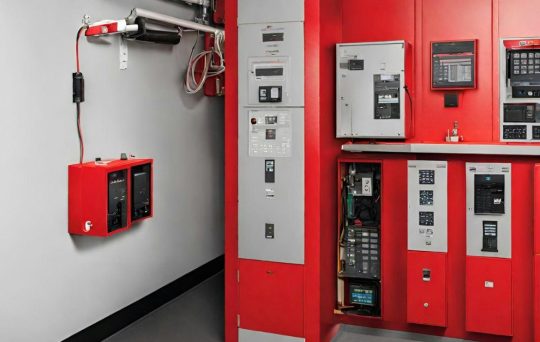
1. Importance of Fire Alarm Systems
The importance of fire alarm systems is evident in several aspects:
Protection from Hazards: They alert individuals in case of a fire, providing sufficient time to evacuate the building.
Reducing Financial Losses: Early detection of fire can minimize material damage and aid in preserving property.
Compliance with Legal Requirements: In many countries, installing fire alarm systems is mandatory in public and commercial buildings.
2. Types of Fire Alarm Systems
Fire alarm systems include several types, such as:
Manual Alarm Systems: Such as manual pull stations activated by individuals during an emergency.
Automatic Alarm Systems: These rely on sensors to detect smoke or heat and automatically issue alerts.
3. Steps for Installing Fire Alarm Systems
The steps for installing fire alarm systems can be summarized as follows:
Initial Assessment: Evaluate the building and identify the most vulnerable areas.
Choosing the Appropriate System: Select the suitable type of system based on the building’s needs.
Installation: Install sensors, alarms, and control panels professionally.
Testing and Confirmation: After installation, the system must be tested to ensure efficient operation.
4. Regular Maintenance
To ensure the continuous operation of the fire alarm system, regular maintenance is crucial. Maintenance includes:
Sensor Checks: Ensure their effectiveness and proper functioning.
Device Testing: Verify that all alarms operate correctly.
System Updates: Consider updating the system to keep pace with technological advancements.

5. Choosing a Professional Installation Company
It’s important to choose a reliable company for installing fire alarm systems. The company should have:
Experience: A long history in installing and maintaining alarm systems.
Licensing: Be licensed and certified by official authorities.
After-Sales Service: Provide support and maintenance services post-installation.
Installing fire alarm systems is a crucial step in protecting lives and property. The right system and professional installation ensure the system’s effectiveness. Don’t hesitate to contact Bidaya Company for a free consultation and reliable installation services.
Installation of Fire Alarm Systems
Fire alarm systems are among the most important safety elements in buildings, playing a vital role in protecting lives and property. Therefore, installing these systems is a complex process requiring expertise and technical knowledge. Here are additional details about installing fire alarm systems.
1. System Design
Before starting the installation process, the fire alarm system must be designed based on several factors, such as:
Building Size: Larger buildings require more complex systems that include multiple sensors and alarms.
Building Usage: The system design varies depending on the building’s purpose (residential, commercial, industrial).
Construction Materials: The materials used in the building affect how smoke and heat spread, impacting sensor installation locations.
2. Types of Sensors
Fire alarm sensors differ based on how they detect fire:
Smoke Sensors: Detect smoke particles in the air and vary between ionization and photoelectric smoke sensors.
Heat Sensors: Detect abnormal increases in temperature and include fixed and two-point sensors.
Flame Sensors: Detect flames using infrared or visible light and are effective in environments where high temperatures can cause false alarms.
3. Control Panels
Central control panels are essential components of the fire alarm system. They manage all sensors and alarms and include:
System Status Display: Shows the status of each sensor in the system, indicating whether it is in normal operation or detecting a fire.
Interaction Capabilities: Allow the user to interact with alerts and manually control the system.
Event Logging and Documentation: Some panels have event logging features, allowing for tracking and documenting any alerts that occur.
4. Safety Procedures During Installation
When installing a fire alarm system, it’s essential to adhere to several safety procedures to avoid any risks, including:
Power Shutdown: Ensure that all electrical systems are turned off during installation to avoid electrical shocks.
Using Appropriate Equipment: Utilize suitable installation tools and equipment to prevent damage to any components during installation.
Providing Adequate Ventilation: If using chemicals or adhesives, ensure proper ventilation to avoid inhaling harmful substances.

5. Training and Awareness
After installing the fire alarm system, training for workers or residents in the building on how to use the system is vital. Training includes:
Recognizing Fire Alarms: Clarifying how to recognize alarm signals and the importance of rapid response.
Evacuation Plans: Explaining the evacuation plan in case of fire, including safe routes and designated meeting areas.
6. Modern Technologies in Fire Alarm Systems
Modern technologies used in fire alarm systems include:
Integration with Other Security Systems: Such as surveillance and cameras, providing an additional level of security.
Alerts via Smartphones: Sending instant alerts to mobile devices in case of fire, allowing for quick action.
Artificial Intelligence Systems: Using AI to analyze data for detecting patterns and potential threats.
Installing fire alarm systems requires technical knowledge and high expertise to ensure their effective operation. It is essential to choose a reliable company like Bidaya Company to ensure the installation of a comprehensive system that complies with international safety standards and achieves maximum security.
Installation of Fire Alarm Systems
The installation of fire alarm systems is a vital step in enhancing safety within any building. These systems require careful planning and a deep understanding of the available technologies. In this context, we will delve into more details about installing fire alarm systems, along with keywords that enhance the article’s visibility in search engines.
1. Preliminary Planning for System Design
Before commencing the installation process, specialists should conduct a comprehensive site assessment. This includes:
Studying the Building Layout: Analyzing the layout to identify the most critical points for sensor installation, such as hallways, rooms, and enclosed spaces.
Identifying Hazard Sources: Pinpointing potential fire outbreak locations, such as kitchens and storage areas, to ensure nearby sensors are installed.

2. Modern Detection Technologies
Modern technologies used in fire alarm systems employ advanced methods to improve detection accuracy, including:
Advanced Sensors: Such as smart sensors capable of distinguishing between smoke from a fire and smoke from cooking.
Nano Technology: Utilizing it to develop lightweight and compact sensors that enhance system effectiveness.
3. Integration with Other Security Systems
Integrating fire alarm systems with other security systems in the facility provides an additional level of protection:
Automatic Fire Suppression Systems: Can work in tandem with alarms to extinguish fire in its early stages.
Audible Alarm Systems: Alert people inside the building to evacuate and can be connected to a public address system.
4. Installation Guidelines
When installing fire alarm systems, a set of guidelines must be followed to ensure efficient installation:
Avoid Interference: Sensors should be installed away from excessive heat sources, such as electric bulbs.
Consider Heights: Determine the appropriate height for sensor installation based on their type. For example, smoke sensors should be installed 30-60 cm from the ceiling.
Correct Orientation: Position sensors effectively toward areas where smoke accumulates.
5. Performance Testing
After installation, comprehensive performance tests should be conducted to verify the system’s effectiveness:
Simulation Tests: Simulate fire scenarios using artificial smoke to ensure the system responds appropriately.
Performance Evaluation: Measure the sensors’ response time and accuracy in detecting fire locations.
6. Periodic Maintenance Strategies
Fire alarm systems require regular maintenance to ensure ongoing efficiency:
Schedule Inspections: Develop a plan to inspect systems periodically, at least once every six months.
System Updates: Consider updating the system in line with the latest available technologies.
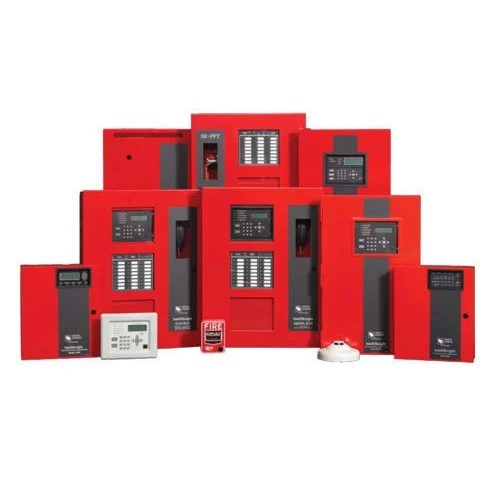
Keywords
Installation of fire alarm systems
Fire protection
Automatic alarm systems
Smoke sensors
Fire system maintenance
Fire detection technologies
Integrated security systems
Importance of alarm systems
Fire system performance testing
Design of fire alarm systems
The installation of fire alarm systems requires dedication and high technical knowledge. Ensure to choose a professional company like Bidaya Company to guarantee an effective system installation that achieves the highest safety standards. If you have any inquiries or need consultation, please do not hesitate to contact us!
#Top-rated fire safety services Dammam#Professional fire suppression system installation Jeddah#Fire safety audits and system installation Jubail#Fire fighting network installation company near me#Certified fire alarm system installers Riyadh#Affordable fire protection installation Medina
0 notes
Text
Top 7 Benefits of Modular Kitchens Coventry Homeowners Should Know — By All Kitchens Fitted
When it comes to designing your dream kitchen, kitchen installation in Coventry has never been more exciting or efficient, thanks to the growing popularity of modular kitchens. At All Kitchens Fitted, we have years of experience transforming homes across Coventry with seamless kitchen installation and professional kitchen setup services that are both stylish and practical.
If you’re considering a kitchen upgrade or a complete new kitchen installation, modular kitchens could be exactly what your home needs. Our certified kitchen installers bring precision, expertise, and attention to detail to every project — ensuring Coventry homeowners get a space that not only looks stunning but works beautifully, too.
Let’s explore the top 7 benefits of choosing a modular kitchen for your Coventry home and how All Kitchens Fitted can bring your vision to life.

1. Fully Customisable to Your Lifestyle
Every homeowner has unique needs, which is why modular kitchens offer unparalleled flexibility. Whether you’re a passionate home chef who needs extra counter space, or a busy family looking for clever storage, a modular kitchen can be tailored to your exact preferences. At All Kitchens Fitted, our expert kitchen assembly team works closely with you to create bespoke layouts, cabinet designs, and worktop options that suit your daily routine and maximise functionality — all within your available space.
2. Faster Installation with Minimal Hassle
Traditional kitchen setups can take weeks or even months. Modular kitchens are designed for speed and precision. Using factory-fabricated units, our reliable kitchen installation services ensure faster turnaround times — so you spend less time waiting and more time enjoying your new space. Thanks to our seamless kitchen installation process in Coventry, disruption to your home is kept to a minimum. We handle every stage, from delivery to kitchen appliance fitting, so you won’t have to juggle multiple tradespeople.
3. Smart Use of Space, Even in Compact Homes
With Coventry homes ranging from historic terraces to new builds, smart space management is key. Modular kitchens make optimal use of every square inch — with features like corner carousels, pull-out pantries, overhead storage, and modular shelves. Our kitchen assembly services include personalised solutions that ensure even small kitchens feel spacious and highly functional, whether you’re living in a flat, bungalow, or detached home.
4. Easy Maintenance and Upgrades
A modular kitchen is designed for easy maintenance and future flexibility. Each unit is independent and accessible, so cleaning is simple and repairs or replacements can be done without disturbing the entire setup. At All Kitchens Fitted, our certified kitchen installers ensure every cabinet, worktop, and appliance is fitted with longevity in mind — making your investment hassle-free for years to come.
5. Sleek, Modern Aesthetics to Elevate Your Home
From minimalist matte finishes to classic wood grains, modular kitchens offer endless styles and colour combinations. We help Coventry homeowners design kitchens that blend perfectly with their home’s aesthetic, whether contemporary or traditional. Our professional kitchen setup team sources durable, premium materials, ensuring your new kitchen looks elegant and stands the test of time.
6. Seamless Integration of Appliances and Accessories
Modern kitchens demand more than just storage. Our kitchen appliance fitting services include the safe and neat installation of hobs, ovens, microwaves, dishwashers, and extractors — all seamlessly integrated into your cabinetry. With All Kitchens Fitted, everything is measured and fitted to perfection, maintaining clean lines and maximising functionality.
7. Long-Term Durability and Value
Choosing a modular kitchen through reliable kitchen installation services is an investment in quality and long-term value. The sturdy construction and modular nature mean parts can be upgraded or modified over time without a full remodel — extending the life of your kitchen and boosting your property’s resale appeal.
Why Choose All Kitchens Fitted for Your Kitchen Installation in Coventry?
As a Coventry-based company, we’re proud to serve the local community with expert kitchen assembly, trusted craftsmanship, and personalised service. Our commitment to high standards, transparent pricing, and client satisfaction has made us a top choice for kitchen installation in Coventry.
✅ Certified Kitchen Installers ✅ Seamless, Reliable Kitchen Installation Services ✅ Expert Kitchen Appliance Fitting ✅ Custom Designs and Local Expertise
📍 Address: 60 Glenmore Dr, Longford, Coventry CV6 6LZ, United Kingdom 📞 Phone: 07774646118 🌐 Website: www.allkitchensfitted.co.uk ✉️ Email: [email protected]
Frequently Asked Questions (FAQs)
Q1. How long does a modular kitchen installation in Coventry take? Typically, our modular kitchen installations are completed within 5–10 working days, depending on kitchen size and customisation. We ensure swift, tidy, and seamless kitchen installation.
Q2. Do you offer appliance fitting as part of the kitchen installation? Yes — our kitchen appliance fitting service covers ovens, hobs, extractors, dishwashers, and more. We ensure they are professionally installed and integrated.
Q3. Can I customise the layout and finishes of my modular kitchen? Absolutely. Our expert kitchen assembly team will help you select layouts, cabinet styles, colours, and materials to match your taste and space.
Q4. Do you handle small kitchen renovations as well as large ones? Yes — whether it’s a compact apartment kitchen or a spacious open-plan home, we offer reliable kitchen installation services for kitchens of all sizes.
Q5. Is your kitchen installation work guaranteed? Yes — All installations carried out by All Kitchens Fitted are covered by a workmanship guarantee for your peace of mind.
If you're ready to bring your kitchen vision to life, contact All Kitchens Fitted today for a free consultation and quote — and discover why we’re Coventry’s trusted choice for professional kitchen setup.
#Certified kitchen installers Coventry#Seamless kitchen installation Coventry#Reliable kitchen installation services Coventry#Expert kitchen assembly Coventry#Kitchen assembly Services in Coventry#Professional kitchen setup in Coventry#New kitchen installation in Coventry
0 notes
Text
Installation of Fire Alarm Systems

Installation of Fire Alarm Systems
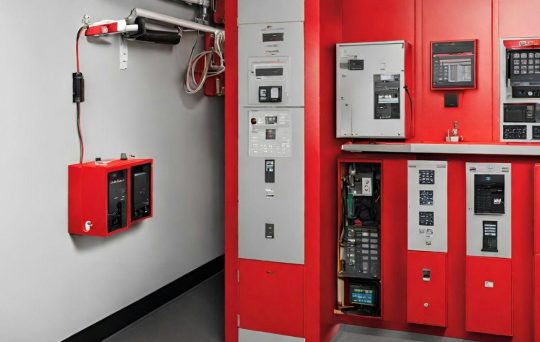
1. Importance of Fire Alarm Systems
The importance of fire alarm systems is evident in several aspects:
Protection from Hazards: They alert individuals in case of a fire, providing sufficient time to evacuate the building.
Reducing Financial Losses: Early detection of fire can minimize material damage and aid in preserving property.
Compliance with Legal Requirements: In many countries, installing fire alarm systems is mandatory in public and commercial buildings.
2. Types of Fire Alarm Systems
Fire alarm systems include several types, such as:
Manual Alarm Systems: Such as manual pull stations activated by individuals during an emergency.
Automatic Alarm Systems: These rely on sensors to detect smoke or heat and automatically issue alerts.
3. Steps for Installing Fire Alarm Systems
The steps for installing fire alarm systems can be summarized as follows:
Initial Assessment: Evaluate the building and identify the most vulnerable areas.
Choosing the Appropriate System: Select the suitable type of system based on the building’s needs.
Installation: Install sensors, alarms, and control panels professionally.
Testing and Confirmation: After installation, the system must be tested to ensure efficient operation.
4. Regular Maintenance
To ensure the continuous operation of the fire alarm system, regular maintenance is crucial. Maintenance includes:
Sensor Checks: Ensure their effectiveness and proper functioning.
Device Testing: Verify that all alarms operate correctly.
System Updates: Consider updating the system to keep pace with technological advancements.

5. Choosing a Professional Installation Company
It’s important to choose a reliable company for installing fire alarm systems. The company should have:
Experience: A long history in installing and maintaining alarm systems.
Licensing: Be licensed and certified by official authorities.
After-Sales Service: Provide support and maintenance services post-installation.
Installing fire alarm systems is a crucial step in protecting lives and property. The right system and professional installation ensure the system’s effectiveness. Don’t hesitate to contact Bidaya Company for a free consultation and reliable installation services.
Installation of Fire Alarm Systems
Fire alarm systems are among the most important safety elements in buildings, playing a vital role in protecting lives and property. Therefore, installing these systems is a complex process requiring expertise and technical knowledge. Here are additional details about installing fire alarm systems.
1. System Design
Before starting the installation process, the fire alarm system must be designed based on several factors, such as:
Building Size: Larger buildings require more complex systems that include multiple sensors and alarms.
Building Usage: The system design varies depending on the building’s purpose (residential, commercial, industrial).
Construction Materials: The materials used in the building affect how smoke and heat spread, impacting sensor installation locations.
2. Types of Sensors
Fire alarm sensors differ based on how they detect fire:
Smoke Sensors: Detect smoke particles in the air and vary between ionization and photoelectric smoke sensors.
Heat Sensors: Detect abnormal increases in temperature and include fixed and two-point sensors.
Flame Sensors: Detect flames using infrared or visible light and are effective in environments where high temperatures can cause false alarms.
3. Control Panels
Central control panels are essential components of the fire alarm system. They manage all sensors and alarms and include:
System Status Display: Shows the status of each sensor in the system, indicating whether it is in normal operation or detecting a fire.
Interaction Capabilities: Allow the user to interact with alerts and manually control the system.
Event Logging and Documentation: Some panels have event logging features, allowing for tracking and documenting any alerts that occur.
4. Safety Procedures During Installation
When installing a fire alarm system, it’s essential to adhere to several safety procedures to avoid any risks, including:
Power Shutdown: Ensure that all electrical systems are turned off during installation to avoid electrical shocks.
Using Appropriate Equipment: Utilize suitable installation tools and equipment to prevent damage to any components during installation.
Providing Adequate Ventilation: If using chemicals or adhesives, ensure proper ventilation to avoid inhaling harmful substances.

5. Training and Awareness
After installing the fire alarm system, training for workers or residents in the building on how to use the system is vital. Training includes:
Recognizing Fire Alarms: Clarifying how to recognize alarm signals and the importance of rapid response.
Evacuation Plans: Explaining the evacuation plan in case of fire, including safe routes and designated meeting areas.
6. Modern Technologies in Fire Alarm Systems
Modern technologies used in fire alarm systems include:
Integration with Other Security Systems: Such as surveillance and cameras, providing an additional level of security.
Alerts via Smartphones: Sending instant alerts to mobile devices in case of fire, allowing for quick action.
Artificial Intelligence Systems: Using AI to analyze data for detecting patterns and potential threats.
Installing fire alarm systems requires technical knowledge and high expertise to ensure their effective operation. It is essential to choose a reliable company like Bidaya Company to ensure the installation of a comprehensive system that complies with international safety standards and achieves maximum security.
Installation of Fire Alarm Systems
The installation of fire alarm systems is a vital step in enhancing safety within any building. These systems require careful planning and a deep understanding of the available technologies. In this context, we will delve into more details about installing fire alarm systems, along with keywords that enhance the article’s visibility in search engines.
1. Preliminary Planning for System Design
Before commencing the installation process, specialists should conduct a comprehensive site assessment. This includes:
Studying the Building Layout: Analyzing the layout to identify the most critical points for sensor installation, such as hallways, rooms, and enclosed spaces.
Identifying Hazard Sources: Pinpointing potential fire outbreak locations, such as kitchens and storage areas, to ensure nearby sensors are installed.

2. Modern Detection Technologies
Modern technologies used in fire alarm systems employ advanced methods to improve detection accuracy, including:
Advanced Sensors: Such as smart sensors capable of distinguishing between smoke from a fire and smoke from cooking.
Nano Technology: Utilizing it to develop lightweight and compact sensors that enhance system effectiveness.
3. Integration with Other Security Systems
Integrating fire alarm systems with other security systems in the facility provides an additional level of protection:
Automatic Fire Suppression Systems: Can work in tandem with alarms to extinguish fire in its early stages.
Audible Alarm Systems: Alert people inside the building to evacuate and can be connected to a public address system.
4. Installation Guidelines
When installing fire alarm systems, a set of guidelines must be followed to ensure efficient installation:
Avoid Interference: Sensors should be installed away from excessive heat sources, such as electric bulbs.
Consider Heights: Determine the appropriate height for sensor installation based on their type. For example, smoke sensors should be installed 30-60 cm from the ceiling.
Correct Orientation: Position sensors effectively toward areas where smoke accumulates.
5. Performance Testing
After installation, comprehensive performance tests should be conducted to verify the system’s effectiveness:
Simulation Tests: Simulate fire scenarios using artificial smoke to ensure the system responds appropriately.
Performance Evaluation: Measure the sensors’ response time and accuracy in detecting fire locations.
6. Periodic Maintenance Strategies
Fire alarm systems require regular maintenance to ensure ongoing efficiency:
Schedule Inspections: Develop a plan to inspect systems periodically, at least once every six months.
System Updates: Consider updating the system in line with the latest available technologies.
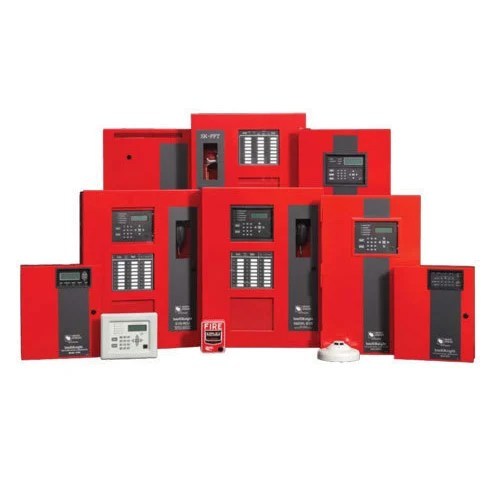
Keywords
Installation of fire alarm systems
Fire protection
Automatic alarm systems
Smoke sensors
Fire system maintenance
Fire detection technologies
Integrated security systems
Importance of alarm systems
Fire system performance testing
Design of fire alarm systems
The installation of fire alarm systems requires dedication and high technical knowledge. Ensure to choose a professional company like Bidaya Company to guarantee an effective system installation that achieves the highest safety standards. If you have any inquiries or need consultation, please do not hesitate to contact us!
#Top-rated fire safety services Dammam#Professional fire suppression system installation Jeddah#Fire safety audits and system installation Jubail#Fire fighting network installation company near me#Certified fire alarm system installers Riyadh#Affordable fire protection installation Medina
0 notes
Text
Installation of Fire Alarm Systems

Installation of Fire Alarm Systems

1. Importance of Fire Alarm Systems
The importance of fire alarm systems is evident in several aspects:
Protection from Hazards: They alert individuals in case of a fire, providing sufficient time to evacuate the building.
Reducing Financial Losses: Early detection of fire can minimize material damage and aid in preserving property.
Compliance with Legal Requirements: In many countries, installing fire alarm systems is mandatory in public and commercial buildings.
2. Types of Fire Alarm Systems
Fire alarm systems include several types, such as:
Manual Alarm Systems: Such as manual pull stations activated by individuals during an emergency.
Automatic Alarm Systems: These rely on sensors to detect smoke or heat and automatically issue alerts.
3. Steps for Installing Fire Alarm Systems
The steps for installing fire alarm systems can be summarized as follows:
Initial Assessment: Evaluate the building and identify the most vulnerable areas.
Choosing the Appropriate System: Select the suitable type of system based on the building’s needs.
Installation: Install sensors, alarms, and control panels professionally.
Testing and Confirmation: After installation, the system must be tested to ensure efficient operation.
4. Regular Maintenance
To ensure the continuous operation of the fire alarm system, regular maintenance is crucial. Maintenance includes:
Sensor Checks: Ensure their effectiveness and proper functioning.
Device Testing: Verify that all alarms operate correctly.
System Updates: Consider updating the system to keep pace with technological advancements.

5. Choosing a Professional Installation Company
It’s important to choose a reliable company for installing fire alarm systems. The company should have:
Experience: A long history in installing and maintaining alarm systems.
Licensing: Be licensed and certified by official authorities.
After-Sales Service: Provide support and maintenance services post-installation.
Installing fire alarm systems is a crucial step in protecting lives and property. The right system and professional installation ensure the system’s effectiveness. Don’t hesitate to contact Bidaya Company for a free consultation and reliable installation services.
Installation of Fire Alarm Systems
Fire alarm systems are among the most important safety elements in buildings, playing a vital role in protecting lives and property. Therefore, installing these systems is a complex process requiring expertise and technical knowledge. Here are additional details about installing fire alarm systems.
1. System Design
Before starting the installation process, the fire alarm system must be designed based on several factors, such as:
Building Size: Larger buildings require more complex systems that include multiple sensors and alarms.
Building Usage: The system design varies depending on the building’s purpose (residential, commercial, industrial).
Construction Materials: The materials used in the building affect how smoke and heat spread, impacting sensor installation locations.
2. Types of Sensors
Fire alarm sensors differ based on how they detect fire:
Smoke Sensors: Detect smoke particles in the air and vary between ionization and photoelectric smoke sensors.
Heat Sensors: Detect abnormal increases in temperature and include fixed and two-point sensors.
Flame Sensors: Detect flames using infrared or visible light and are effective in environments where high temperatures can cause false alarms.
3. Control Panels
Central control panels are essential components of the fire alarm system. They manage all sensors and alarms and include:
System Status Display: Shows the status of each sensor in the system, indicating whether it is in normal operation or detecting a fire.
Interaction Capabilities: Allow the user to interact with alerts and manually control the system.
Event Logging and Documentation: Some panels have event logging features, allowing for tracking and documenting any alerts that occur.
4. Safety Procedures During Installation
When installing a fire alarm system, it’s essential to adhere to several safety procedures to avoid any risks, including:
Power Shutdown: Ensure that all electrical systems are turned off during installation to avoid electrical shocks.
Using Appropriate Equipment: Utilize suitable installation tools and equipment to prevent damage to any components during installation.
Providing Adequate Ventilation: If using chemicals or adhesives, ensure proper ventilation to avoid inhaling harmful substances.

5. Training and Awareness
After installing the fire alarm system, training for workers or residents in the building on how to use the system is vital. Training includes:
Recognizing Fire Alarms: Clarifying how to recognize alarm signals and the importance of rapid response.
Evacuation Plans: Explaining the evacuation plan in case of fire, including safe routes and designated meeting areas.
6. Modern Technologies in Fire Alarm Systems
Modern technologies used in fire alarm systems include:
Integration with Other Security Systems: Such as surveillance and cameras, providing an additional level of security.
Alerts via Smartphones: Sending instant alerts to mobile devices in case of fire, allowing for quick action.
Artificial Intelligence Systems: Using AI to analyze data for detecting patterns and potential threats.
Installing fire alarm systems requires technical knowledge and high expertise to ensure their effective operation. It is essential to choose a reliable company like Bidaya Company to ensure the installation of a comprehensive system that complies with international safety standards and achieves maximum security.
Installation of Fire Alarm Systems
The installation of fire alarm systems is a vital step in enhancing safety within any building. These systems require careful planning and a deep understanding of the available technologies. In this context, we will delve into more details about installing fire alarm systems, along with keywords that enhance the article’s visibility in search engines.
1. Preliminary Planning for System Design
Before commencing the installation process, specialists should conduct a comprehensive site assessment. This includes:
Studying the Building Layout: Analyzing the layout to identify the most critical points for sensor installation, such as hallways, rooms, and enclosed spaces.
Identifying Hazard Sources: Pinpointing potential fire outbreak locations, such as kitchens and storage areas, to ensure nearby sensors are installed.
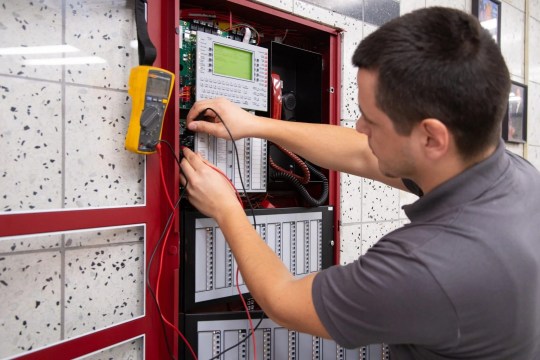
2. Modern Detection Technologies
Modern technologies used in fire alarm systems employ advanced methods to improve detection accuracy, including:
Advanced Sensors: Such as smart sensors capable of distinguishing between smoke from a fire and smoke from cooking.
Nano Technology: Utilizing it to develop lightweight and compact sensors that enhance system effectiveness.
3. Integration with Other Security Systems
Integrating fire alarm systems with other security systems in the facility provides an additional level of protection:
Automatic Fire Suppression Systems: Can work in tandem with alarms to extinguish fire in its early stages.
Audible Alarm Systems: Alert people inside the building to evacuate and can be connected to a public address system.
4. Installation Guidelines
When installing fire alarm systems, a set of guidelines must be followed to ensure efficient installation:
Avoid Interference: Sensors should be installed away from excessive heat sources, such as electric bulbs.
Consider Heights: Determine the appropriate height for sensor installation based on their type. For example, smoke sensors should be installed 30-60 cm from the ceiling.
Correct Orientation: Position sensors effectively toward areas where smoke accumulates.
5. Performance Testing
After installation, comprehensive performance tests should be conducted to verify the system’s effectiveness:
Simulation Tests: Simulate fire scenarios using artificial smoke to ensure the system responds appropriately.
Performance Evaluation: Measure the sensors’ response time and accuracy in detecting fire locations.
6. Periodic Maintenance Strategies
Fire alarm systems require regular maintenance to ensure ongoing efficiency:
Schedule Inspections: Develop a plan to inspect systems periodically, at least once every six months.
System Updates: Consider updating the system in line with the latest available technologies.

Keywords
Installation of fire alarm systems
Fire protection
Automatic alarm systems
Smoke sensors
Fire system maintenance
Fire detection technologies
Integrated security systems
Importance of alarm systems
Fire system performance testing
Design of fire alarm systems
The installation of fire alarm systems requires dedication and high technical knowledge. Ensure to choose a professional company like Bidaya Company to guarantee an effective system installation that achieves the highest safety standards. If you have any inquiries or need consultation, please do not hesitate to contact us!
#Top-rated fire safety services Dammam#Professional fire suppression system installation Jeddah#Fire safety audits and system installation Jubail#Fire fighting network installation company near me#Certified fire alarm system installers Riyadh#Affordable fire protection installation Medina
0 notes